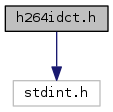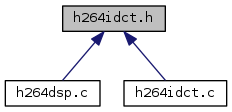|
FFmpeg
|
h264idct.h File Reference
#include <stdint.h>
Include dependency graph for h264idct.h:

This graph shows which files directly or indirectly include this file:

Go to the source code of this file.
Macros | |
| #define | H264_IDCT(depth) |
Macro Definition Documentation
| #define H264_IDCT | ( | depth | ) |
Value:
void ff_h264_idct_add16_ ## depth ## _c(uint8_t *dst, const int *blockoffset, int16_t *block, int stride, const uint8_t nnzc[6*8]);\
void ff_h264_idct_add16intra_ ## depth ## _c(uint8_t *dst, const int *blockoffset, int16_t *block, int stride, const uint8_t nnzc[6*8]);\
void ff_h264_idct8_add4_ ## depth ## _c(uint8_t *dst, const int *blockoffset, int16_t *block, int stride, const uint8_t nnzc[6*8]);\
void ff_h264_idct_add8_422_ ## depth ## _c(uint8_t **dest, const int *blockoffset, int16_t *block, int stride, const uint8_t nnzc[6*8]);\
void ff_h264_idct_add8_ ## depth ## _c(uint8_t **dest, const int *blockoffset, int16_t *block, int stride, const uint8_t nnzc[6*8]);\
these buffered frames must be flushed immediately if a new input produces new the filter must not call request_frame to get more It must just process the frame or queue it The task of requesting more frames is left to the filter s request_frame method or the application If a filter has several the filter must be ready for frames arriving randomly on any input any filter with several inputs will most likely require some kind of queuing mechanism It is perfectly acceptable to have a limited queue and to drop frames when the inputs are too unbalanced request_frame This method is called when a frame is wanted on an output For an input
Definition: filter_design.txt:216
these buffered frames must be flushed immediately if a new input produces new output(Example:frame rate-doubling filter:filter_frame must(1) flush the second copy of the previous frame, if it is still there,(2) push the first copy of the incoming frame,(3) keep the second copy for later.) If the input frame is not enough to produce output
Definition at line 24 of file h264idct.h.
Generated by
 1.8.11
1.8.11